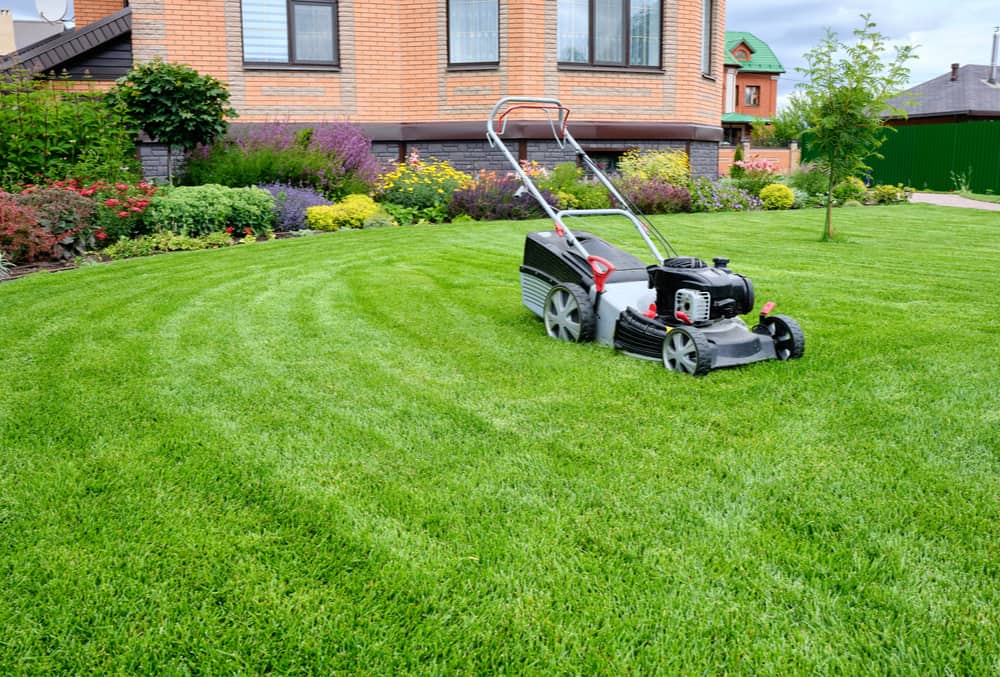Should You Invest In A Striping Kit For A Lawn Mower? Find Out Here
Have you ever looked at the turf of a ballpark or golf course and wondered how the groundsmen get the grass to look so immaculate?
The turf has straight lines that look like a tapestry of perfection. Well, this isn’t the work of lawn paint or a special type of grass species. It is, in fact, a method of mowing known as “lawn striping.”
For those of us who like to take time and precision with our lawn, a well-striped turf can help you stand out from everyone else. It is often a sign of sheer skill.
While this type of lawn striping is more synonymous with baseball fields and golf courses, it has become more popular with people’s yards over the years.
With the advent of commercial striping kits for lawnmowers, homeowners can now transform their yards into picture-perfect lawns.
There is a range of models available for ride-on mowers as well as walk-behind types. Whatever the model, these striping kits can create stunning stripes on your lawn.
The question remains, however – is a striping kit for your lawnmower worth it or not? We have the answer for you today.
Read on as we discuss how these striping kits work for your lawnmower and if they are the right option for you and your lawn.
How Does Lawn Striping Work?
There is no magic behind lawn striping. Every blade of grass in your lawn or a field has a waxy side known as a cuticle. This retains and directs water to the grass roots to keep them growing and in a healthy condition.
Without this, lawn striping would not be possible. This waxy cuticle actually reflects light differently from the opposite side which is paler in color.
When a striping machine goes over a blade of grass, it bends the blade in opposite directions creating the striped effect. For the best results, lawn striping should be done on grasses with colder temperatures.
These tend to retain more water and, therefore, bend more easily. This results in the stripes appearing more efficiently, especially if the grass is also tall enough to bend.
This is ideally around 2 inches in height. Blades of grass that are lower in height than this do not bend so easily and, if they do bend, the effect will not be as great.
How A Lawn Striping Kit Works
To stripe your lawn, you will need to attach a simple add-on to your lawnmower. You need to apply a sufficient amount of weight to bend the grass and achieve the light-dark color effect.
For this, you will need a lawn roller. This is a very heavy, cylindrical metal or plastic garden tool.
Many lawn rollers attach to a sit on the lawnmower’s rear end. A great example is this model from Agri-Fab. If you do not own a sit-on mower, there are also hand-held pushed models such as this from Goplus.
Along with your roller, you will need a lawn striping kit. There are many of these kits available on the market but a fine example is this product from Toro. You simply attach this to your lawnmower and let it transform your lawn into a striped haven.
For the best results, a lawn striping kit should be attached to the back of your mower. This is a weighted bar that drags behind the mower to press down the grass further and bend it to reflect the light more.
While a striping kit is the best way to get stripes on your lawn, it’s not always necessary to use one. You could get striped results from using the safety strip on the rear of a standard lawnmower.
However, investing in a striping kit will usually make the lines clearer and a lot crisper.
You can purchase these kits at most hardware stores as well as online. The most basic kits tend to have heavy rubber mats that drag along the turf.
However, some quality lawn mowers come pre-equipped with these mats as a standard feature. Therefore, striping is sometimes possible with a regular mower.
The highest quality striping kits look more like a line of wheels. Sometimes it is simply a cylindrical bar that is attached to the back of a mower and trails behind as you move.
There are also some DIY options out there too. Some people attach a rubber mat to the back of their mower or even a PVC pipe capped at both ends and filled with water or sand.
This will essentially do the same job by pushing down and bending the grass. But, the resulting lines may not be as evident when compared with a lawn striping kit.
Before you purchase a lawn roller and lawn striping kit, ensure that they are compatible with your lawnmower size. Moreover, you may need to fill the base of the lawn roller with sand or water before use to get the desired weight to bend the grass properly.
Basics Of Striping A Lawn
When you stripe your lawn, you will need to begin by mowing around its perimeter. This will help you create a working zone that can be used to make u-turns in order to make the most consistent parallel lines.
The last thing you want is to look back and find one line is crossing another or they are not perfectly straight.
Fortunately, creating a stripe pattern is pretty straightforward. All you need to do is turn around carefully at the end of a line and cut a straight line in the opposite direction of the adjacent one.
It’s just like mowing your lawn but with the added pressure of ensuring the lines are consistent.
If you want to make a grid pattern, you need to go back over the lawn again but from the opposite side. So, move perpendicular to your existing stripes and repeat the process in this direction.
You can also create diagonal patterns with your striping kit. You follow the same process as when you make a grid pattern but angle toward the edges of the lawn instead.
We recommend starting with simple consistent lines. After you have gotten to grips with the lawn striping machine and are more confident, you can then tackle more intricate patterns.
Benefits Of Lawn Striping
One of the main benefits of lawn striping is that it can promote healthy grass growth.
Mowing your lawn in one single direction can form grooves, holes, ruts, and even spots of low growth. This can lead to an uneven and mottled patch of lawn.
If a lawn is uneven, taller blades of grass are more prone to bending over and covering shorter blades.
They act as a canopy and block any sunlight from reaching the smaller blades of grass. This will continue until the blades eventually die.
If you mow your lawn in two directions and attempt a striped effect, it can limit or even prevent most lawn defects and deformities. Low growth spots become less likely so you are left with a more pristine and uniformed lawn.
This is because all of the blades of grass, tall and short, get the same amount of sunlight so they thrive and continue to live.
However, do not cut the grass too short as lawn striping will not work so well. The taller the blades of grass are, the better they will bend under the weight of the roller.
This results in a greater surface of the lawn reflecting sunlight which, in turn, leads to a more natural lawn striping effect.
Blades of grass should be between 2.5 inches and 4 inches for lawn stripes to look their best. Therefore, you should avoid cutting your grass too short as it will not bend and reflect enough sunlight to create the crisp stripe effect.
Can You Repeat The Same Pattern When Lawn Striping?

You should mow regularly to maintain a grass height of 2.5 to 4 inches.
This could be every week or every two weeks during the summer months but only every two to five weeks during the fall and throughout winter.
But, when you go to re-stripe your lawn, you should not go over the same pattern and direction more than every two weeks. If you do this, the grass could become permanently flat and die.
For the best results, we suggest you mow in alternate patterns every two weeks or so. So, if you mow east to west (diagonally) on one occasion, mow north to south (horizontally) on your next mowing session.
Is Lawn Striping Suitable For All Species Of Grass?
The best types of grass for lawn striping are cold-season grasses such as Fine Fescues or Tall grasses.
These tend to flourish in the spring and early fall when temperatures range from 65 to 80 degrees Fahrenheit. These grasses are longer and boast more flexible blades that will bend more easily under a lawn mower’s pressure.
Warm-season grasses such as St. Augustine and Bermuda do not bend so easily. This is because they are shorter and their blades are firmer.
While you can stripe grasses that experience midsummer temperatures of 75 to 90 degrees Fahrenheit, the blades will usually spring back up and the stripes will not stay as clear for long.
In Summary
If you want to make stripes in your garden, it’s mostly down to your technique. You can have the best striping kit out there but if you use it incorrectly, your striping results will not be satisfactory.
Lawn striping can be a great way to improve your lawn’s health, however. So, if you find your lawn has a few low spots and is uneven in patches, a lawn striping kit is certainly worth considering.
Just remember to alternate the direction of mowing every few weeks to increase the lawn’s absorption of the sunlight. This could lead to a pristine lawn in no time.
Just ensure your lawn is as healthy as possible before going down the lawn striping route. Once your lawn’s health is on the mend, a striping kit could make all the difference in the world.


